
A bathroom is a room in which people wash their bodies or parts of their bodies. It can contain one or more of the following plumbing fixtures: a shower, a bathtub, a bidet, and a sink. The inclusion of a toilet is common. There are also specific toilet rooms, only containing a toilet, which in North American English tend to be called "bathrooms", "powder rooms" or "washrooms", as euphemisms to conceal their actual purpose, while they in British and Irish English are known as just "toilets" or possibly "cloakrooms" - but also as "lavatories" when they are public.

A hammam, called a Moorish bath and a Turkish bath by Westerners, is a type of steam bath or a place of public bathing associated with the Islamic world. It is a prominent feature in the culture of the Muslim world and was inherited from the model of the Roman thermae. Muslim bathhouses or hammams were historically found across the Middle East, North Africa, al-Andalus, Central Asia, the Indian subcontinent, and in Southeastern Europe under Ottoman rule.

Oakland is the academic and healthcare center of Pittsburgh and one of the city's major cultural centers. Home to three universities, museums, hospitals, shopping venues, restaurants, and recreational activities, this section of the city also includes two city-designated historic districts: the mostly residential Schenley Farms Historic District and the predominantly institutional Oakland Civic Center Historic District, as well as the locally-designated Oakland Square Historic District.

Schenley Park is a large municipal park in Pittsburgh, Pennsylvania, United States. It is located between the neighborhoods of Oakland, Greenfield, and Squirrel Hill. It is also listed on the National Register of Historic Places as a historic district. In 2011, the park was named one of "America's Coolest City Parks" by Travel + Leisure.

Bathing is the immersion of the body, wholly or partially, in a medium, usually a liquid or heated air. It may be for personal hygiene, religious ritual, or therapeutic purposes. By analogy, especially as a recreational activity, the term is also applied to sun bathing and sea bathing.
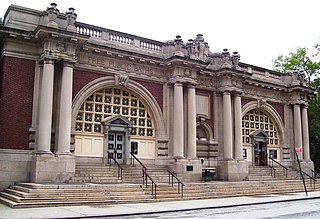
Public baths originated when most people in population centers did not have access to private bathing facilities. Though termed "public", they have often been restricted according to gender, religious affiliation, personal membership, and other criteria.

A spa is a location where mineral-rich spring water is used to give medicinal baths. Spa towns or spa resorts typically offer various health treatments, which are also known as balneotherapy. The belief in the curative powers of mineral waters goes back to prehistoric times. Such practices have been popular worldwide, but are especially widespread in Europe and Japan. Day spas and medspas are also quite popular, and offer various personal care treatments.
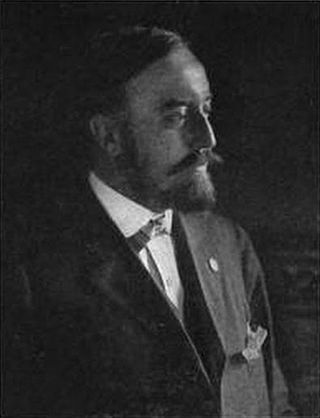
Henry Hornbostel was an American architect and educator. Hornbostel designed more than 225 buildings, bridges, and monuments in the United States. Twenty-two of his designs are listed on the National Register of Historic Places, including the Oakland City Hall in Oakland, California and the Soldiers and Sailors Memorial Hall and Museum and University Club in Pittsburgh, Pennsylvania.
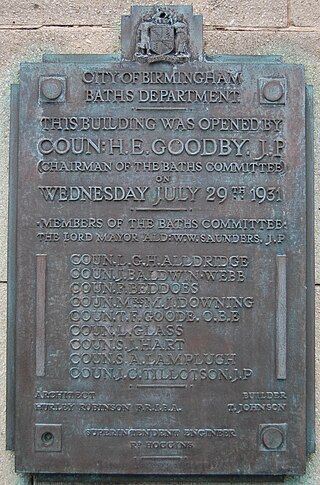
The Birmingham Baths Committee was an organisation responsible for the provision and maintenance of public swimming and bathing facilities. Birmingham City Council funded, constructed and ran bathing facilities throughout the city. The movement to develop baths and wash houses in Britain had its impetus with the rapid urbanisation of the Industrial Revolution, which was felt acutely in Birmingham, one of England's powerhouses.

Frederick John Osterling was an American architect, practicing in Pittsburgh from 1888.
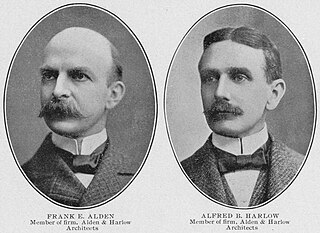
Longfellow, Alden & Harlow, of Boston, Massachusetts, and Pittsburgh, Pennsylvania, was the architectural firm of Alexander Wadsworth Longfellow Jr. (1854–1934), Frank Ellis Alden (1859–1908), and Alfred Branch Harlow (1857–1927). The firm, successors to H. H. Richardson, continued to provide structures in the Romanesque revival style established by Richardson that is often referred to as Richardsonian Romanesque.

The Braddock Carnegie Library in Braddock, Pennsylvania, is the first Carnegie Library in the United States. As such, the library was named a National Historic Landmark in 2012, following its listing on the National Register of Historic Places in 1973, and is on the Pittsburgh History and Landmarks Foundation's List of Historic Landmarks.

Rutan & Russell was an American architectural firm from Pittsburgh, Pennsylvania, active from 1896 to 1922. The named partners were Frank E. Rutan (1863–1911) and Frederick A. Russell (1861–1921), with the later additions of Edward P. Russell (1868–1920) and Eric Fisher Wood (1889–1962), a notable architect in his own right.

The James Lick Baths in the South of Market District of San Francisco, California is a San Francisco Designated Landmark combining aspects of public bathing and self-service laundry.
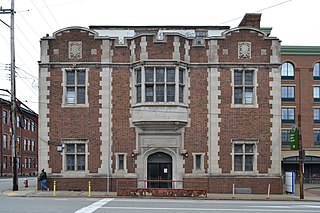
The Oliver Bath House is located at 38 S 10th Street in the South Side Flats neighborhood of Pittsburgh, Pennsylvania. Built in 1915 in the Tudor Revival and Gothic Collegiate architectural style, the building today serves as a public swimming pool.
The following is a timeline of the history of the city of Pittsburgh, Pennsylvania, US.

St. Augustine Church is a historic Roman Catholic church in the Lawrenceville neighborhood of Pittsburgh, Pennsylvania. It has remained in use as a parish church since construction, currently serving Saint Pio of Pietrelcina Parish, which with St. Maria Goretti forms the Bloomfield/Garfield/Lawrenceville Grouping within the Diocese of Pittsburgh. The church has been operated by the Capuchin Friars since 1873 and is the headquarters of the Capuchin Province of St. Augustine.

The Tufa Bridges are two bridges made of tufa stone located in Schenley Park in Pittsburgh, Pennsylvania. Built in 1908 by George W. Burke, the bridges currently serve as part of a footpath within the park.

The Lawrenceville Historic District is a U.S. historic district in Pittsburgh, Pennsylvania, which encompasses the majority of the Lawrenceville neighborhood. The historic district includes 3,217 contributing resources, many of which are rowhouses, commercial buildings, and former industrial properties built between the 1830s and early 20th century. The district was listed on the National Register of Historic Places in 2019.
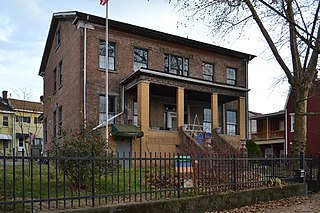
The Mowry-Addison Mansion is a historic house in the Upper Lawrenceville neighborhood of Pittsburgh, Pennsylvania, and a contributing property in the Lawrenceville Historic District. It was built in 1830–32 by Peter Mowry, a physician, and was originally part of a large estate that was subdivided into residential lots in 1872. The house is notable as a rare example of relatively well preserved Greek Revival architecture in Pittsburgh, and exemplifies the typical pattern of development in Lawrenceville in the mid to late 19th century. In 2020, the building was nominated as a Pittsburgh historic landmark by Preservation Pittsburgh, which stated that the mansion "is one of the last remaining and most significantly preserved regional ribbon farm dwellings from its period of construction."

























